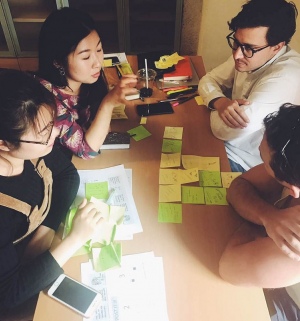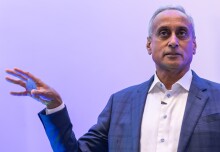

An Imperial academic talks about the Dyson School of Design Engineering's success redressing the gender imbalance of undergraduate students.
Dr Leila Sheldrick discusses the work being done to attract more female engineering undergraduates.
Her comments were published in The Engineer 23 June
Dr Sheldrick writes:
When I started my undergraduate degree in 2003 I was one of only seven women in a class of 50. It’s an experience many will recognise, and even today many engineering courses have a stark gender imbalance.
Yet this autumn when our new undergraduate students turn up for The Dyson School of Design Engineering’s 2017 MEng Design Engineering course there will, if all goes according to plan, be more women than men. In fact, more than 52 per cent of the projected intake will be female.
So why is this course different? Could design engineering be a new device in our toolkit to encourage more women into engineering?
With the UK having the lowest percentage of female engineering professionals in Europe at less than ten per cent, I think it is important to briefly explore some of the elements that I think is making design engineering attractive to a new generation of women, and how these might be expanded elsewhere to encourage women into the field.
The Dyson School of Design Engineering
The School, which is the first of its kind in the UK, is now in its third year of operation and growing steadily.
It was created to establish an undergraduate MEng in Design Engineering, and provide a home for our two postgraduate programmes: Global Innovation Design and Innovation Design Engineering (IDE). The IDE course has been running in partnership with the nearby Royal College of Art for over 35 years. It is fair to say that course has helped to shape the landscape of design engineering in the UK.

Teams work collectively on course projects
The following year, however, the school was established and the more traditional routes of engineering recruitment were used. Although we had an equal number of female applicants, the number of male applicants rose significantly resulting in our 2016 intake containing only 13 female undergraduates compared to 42 males.
We knew we were still learning about the difficult balance of recruitment, and we had to go back to the drawing board to attract more female applicants in 2017.
The key ingredient in our revised approach to recruitment is being far more proactive in outreach activities. This has included regular engagements with careers days and teacher conferences as well as hosting workshops to give visitors a taste of design engineering.
We have also improved how we’ve targeted and pitched the degree, to emphasise the variety of real world design engineering projects and subjects featured in the curriculum.
Together, these approaches have essentially helped to advertise design engineering and establish the undergraduate programme’s reputation as a distinct type of course that is unlike any other engineering programme.
The result is that this October, we are looking forward to welcoming 33 new female students and 30 new male students. A marked increase and an exciting trend as the programme continues to grow.
Innovative role models
Perhaps the single most important factor that helps us to promote this course to aspiring applicants are the success stories that come out of the postgraduate programmes.
One great example is Virginia Gardiner who founded the social innovation company Loowatt that is developing eco-friendly waterless toilets.
Loowatt loos have a range of applications from more eco-friendly festivals to improving sanitation in developing countries. Loowatt recently won the Green Festival Supplier Award at the Festival Supplier Awards 2017.
Another is Elena Dieckmann, who is now one of my PhD students and winner of Innovate UK’s 2016 Women in Innovation Awards. She has established Aeropowder, a company using feathers collected from poultry farms normally considered waste, and turning them into useful and sustainable materials.
One of our students graduating this summer Theresa Ohm, is commercialising her idea of bringing flavour into the digital world. Flavoca uses tools inserted into the mouth, which creates a tuneable current to stimulate the taste buds and give artificial sound feedback when chewed. One example could see this technology being potentially adopted by the gaming world to make experiences in virtual reality more lifelike.
Female graduates from our courses are also leading on corporate design strategy in companies as diverse as Capital One, the bank holding company, and the World Agroforestry Centre, which seeks to harness the benefits that trees provide for agriculture, livelihoods and the resilience of the planet.
These inspiring women – and many others like them that have graduated from our programmes – are our best adverts and our best assets. They are pioneers, shaping the face of the industries they work in, and providing inspiration to the next generation coming through.
The ethos
The world is changing at an increasing pace, and so too is the role of the design engineer – the contexts that they work in, the types of products (and increasingly services) that they create, and the tools they use to do it.
As we shape our new undergraduate programme, we are aware that we’re training our students to do jobs that don’t exist yet and to be the creators of their own jobs.
To equip our students to be these future leaders, we spent a lot of time developing the School’s ethos early on and discussing what it means to be a design engineer in the 21st Century.
Our definition is that Design Engineering is the fusion of both design thinking and engineering knowledge and practice within a culture of innovation and enterprise.
This ethos has helped to shape our curriculum to be broad, applied and future focussed. In my opinion, these are three key ingredients in training the design engineers of the future.
The breadth comes from the mix of skills and subjects our students are exposed to, ranging from fundamental science and mechanical engineering, through to robotics and electronics, and human factors and aesthetics.
The application comes through an emphasis on assessment through project work as opposed to exams. The curriculum requires students to take what they’ve learned and develop ideas that take them from the research stage all the way to the development of final working prototypes.
They also have the opportunity to work on real briefs with real applications, which they work on with a range of external companies who come into support the project work.
The future focus is added through teaching fed by the cutting-edge research happening at Imperial such as 3D printing and machine learning, and by encouraging the students to think outside the box and tackle large, real-world problems.
This ambitious curriculum attracts people who want to be challenged. They learn to embrace diversity, work closely with others, and draw on the broad expertise of their peers to realise their ideas.
The focus on applied project work allows them to practice ‘doing’ and creative problem solving – which builds confidence and capability, and ultimately much stronger graduates that create much stronger solutions.
All these factors chime well with our female students.
It also represents a huge opportunity for increasing diversity in the field.
It opens up new types of roles, empowering students with a broad set of skills, and illustrating to them opportunities to help shape the world around them.
Room to improve
We’ve made great strides in the balance and promotion of young women at the school, but there is still a great deal of room for improvement. For example, we cannot yet boast an even split in our teaching staff, where women are less than a quarter of academics at present.
This highlights the importance of not only working on our student intakes but on shoring up the pipeline of women entering the workforce and remaining in long fruitful careers in design engineering.
Time to reflect
International Women in Engineering Day gives us a time to reflect on the achievements of female engineers.
As we move forward, I hope young women looking to get into design engineering will have more female role models to be inspired by.
I believe this will not only be critical to helping encourage young women into the field, but also to ensure they stay, and play their part in shaping our future workplaces and economies.
We’ve got a long way to go, but it feels like places like the Dyson School is beginning to make inroads into redressing the gender imbalance in engineering education.
The simple fact is, if the technologies of the future are to be truly representative and useful to all of us in society, then we need more women design engineers rising up the ranks.
Article text (excluding photos or graphics) available under an Attribution-NonCommercial-ShareAlike Creative Commons license.
Photos and graphics subject to third party copyright used with permission or © Imperial College London.
Reporter
Colin Smith
Communications and Public Affairs

Contact details
Email: press.office@imperial.ac.uk
Show all stories by this author




Leave a comment
Your comment may be published, displaying your name as you provide it, unless you request otherwise. Your contact details will never be published.